
Access to the Central Bank of Ireland Archives, which were opened to public access in 2017, has revealed a great deal of information about the background to the production of the Irish World War 2 Series A Banknote issues. Much of the information here is based on a detailed examination of the archive, in addition to an analysis of the banknotes which has been on-going since the early 1970s. The core of the content on this page was first published in Coin News, March 2016.
A 64 page soft cover booklet on the war code notes is availalable, Scatter Risk and Special Markings, The Irish World War II 'War Code' Banknote Issues, 1940 - 1944.
Five denominations had war codes incorporated into their designs: 10 Shillings, £1, £5, £10, £20
Ireland, though covertly disposed towards the Allies during the Second World War, was very much a cut off and isolated place. The war years were officially termed 'The Emergency' in the Republic of Ireland, after the passing of the Emergency Powers Act, 1939 [5].
This is reflected in most Irish legal tender banknote issues of the period 1940-1944, which bear a Special Identification Marking [CBIAR] (SIM), coloquially known as a 'war code', on the standard Legal Tender Note design for all denominations except the £50 and £100 notes.
The SIM war code takes the form of a coloured letter in a circle on the top left and bottom right of the face of each denomination. War code notes are a highly collectible variation of the Series A banknotes, and include some of the rarest and most interesting issues of modern Irish paper money.

The SIM was an extra security feature, used to keep track of the Irish banknotes from the time of their production in England to their being delivered safely to Ireland. Like the dates on the banknotes, it appears that the code letters were chosen at random by the Issuing Authority .
The main danger to the banknotes would have been from hostile action, bombing for example, most likely at the printing facility in England, or during transit to Ireland. Such an occurrence could have destroyed the notes, or rendered them very prone to theft.
Should such a loss have occurred, then it would have been a relatively simple procedure, knowing the quantities of banknotes printed under each SIM, to identify the losses and where necessary to cancel by decree all notes bearing a particular overprint. Such may have been the intention. However, there is no record of any batch of notes having been so cancelled [CBIAR].
Every print order specified a certain code letter for each denomination. The code for that denomination was changed by the Issuing Authority on the next print run [CBIAR].
The war code banknotes straddle the era when the Currency Commission Ireland was wound up and replaced by the Central Bank of Ireland. Thus, the variety appears under each of the Issuing Authorities.
Linked Picture Pages of War Code Notes
Currency Commission Ireland War Code Notes Type 4 1940-42
Central Bank of Ireland 1943 War Code Specimen Images
Central Bank of Ireland War Code Notes Type 5 1943-44
Twenty eight different SIM codes were used as special markings. Spread across the five lower denominations, they employ twenty different letters. The letters I, O, Q, U, X, and Z were not used. No pattern to their occurrence is apparent. The code letters were probably chosen at random.
All of the codes are distinctively coloured. The colour tone varies slightly for most of the codes. This is normal, and probably due to variations in the ink supply, the ink itself, or in the force in the press used to print the codes, or a combination of all these factors.
For a few of the codes, there is a very significant variation in colour shade. These are the three blue codes (10 Shillings: H; £1: Y; £20 A), which vary from a pale sky blue to a very dark blue. The occurrence of the variation is apparently randomly spread throughout the dates of issue. The difference in shades is most marked in the H code on the Ten Shilling notes.
Below is a chart of all of the letters of the alphabet used as Special Identification Markings. Click on a code letter for an example of a banknote with that war code letter.
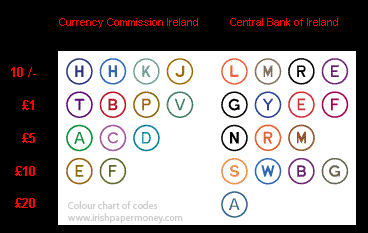
Currency Commission Ireland War Code Denominations
The four lower denominations (10 Shillings through to Ten Pounds) of Currency Commission notes were printed with various war codes in the period 1940 to 1942.

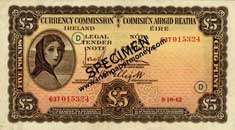
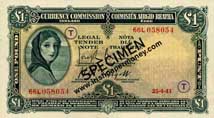
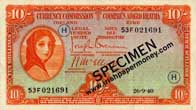
In 1943 The Central Bank of Ireland was created in place of the Currency Commission. Special Identification Markings appear on the five lower denominations of the Central Bank issue from 1943 to 1944. The Code was discontinued on banknotes dated from 1945 onwards.
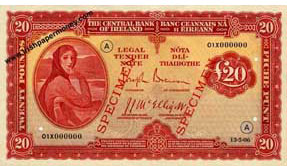

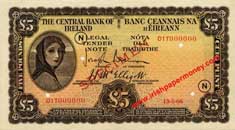
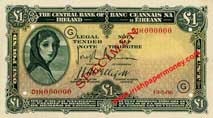
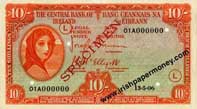
With the onset of the London Blitz on 7 September 1940, and the constant aerial bombing thereafter, the Currency Commission in Ireland decided it was necessary to guard against the possibility of Irish Legal Tender Notes being ‘scattered’ as a result of war action, either during their production in London, or in transit to Ireland [CBIAR].
The Commission suggested the addition of special markings to the notes to guard against any such event.
Printing of the special markings continued up to VE Day [CBIAR].
Central Bank of Ireland archives reveal that the war code special marking is not actually an overprint on the notes, but an integral part of the design, printed first so as to be under the printing of the notes, and thus non-removable.
The war code banknotes are a well-known Type within the Irish Legal Tender Notes [Young, 1972; Mac Devitt, 2019; Banknote Yearbook, 2015]. The story behind the creation of the Irish World War 2 issue notes is less well-known, and the background to their creation was largely unknown until the recent release to the public of the Central Bank of Ireland archives.
The term used from the outset by the Currency Commission for the war code is ‘Special Marking’ or ‘Special Identification Marking’, which makes a good acronym, SIM. This acronym is used here in place of the old acronym ETO, 'Emergency Tracer Overprint', which is no longer an accurate descriptive term.
There are 53 Ten Shilling; 51 One Pound; 41 Five Pound; 24 Ten Pound; and 11 Twenty Pound note dates for the war code notes, making a total of 180 [CBIAR] to collect.
£5 notes were the first denomination to enter circulation, probably in March 1942 [CBIAR].
As of November 2021, at least one example of each of the dates of all the denominations of war code notes have been recorded except for one £20 note date: 4.11.43.
The first and last dates of each code letter are listed in Table 1 at the end of the page.
The Emergency in the Republic of Ireland at the outbreak of The Second World War in 1939 lead promptly to consideration being taken by the Currency Commission Ireland of the effect of the war and the state of emergency on the Irish banking system, and an Extraordinary Issue of extra Consolidated Bank Notes had been created to meet any extra demand in the event of a run on the Irish banks.
When German attacks on London started in 1940, a far greater threat was identified in the possibility of the production of Legal Tender Notes being compromised.
The notes were printed by Waterlow Ltd in London and each batch was then shipped to Ireland by train and ship. The possibility that some or all of a batch could be lost or stolen - scattered, as the Currency Commission termed it - was very real, and it was quickly decided that a secure solution would have to be arrived at.
One can picture the generic ‘smoke filled room’ with the members of the Currency Commission brainstorming on a security solution which would address the possibility of the loss of Legal Tender Notes due to war actions. A possible solution was arrived at quite quickly, with advice from consultants, and one of the original suggestions, designed not quite on the back of a beer mat, was quite close to the actual solution that was put into operation.
A Currency Commission meeting of 24 September 1940 resulted in a letter to Waterlow detailing the decision arrived at by the Commission and the proposed ideas for possible design alterations to the Legal Tender Notes.
The Currency Commission was considering the desirability of printing a distinctive marking for the duration of the war on notes of each print order from Waterlow so that should any of the notes be scattered due to war action either at the printers’ premises or in transit to Ireland, the public could be warned against accepting such notes.
The proposal was that the markings should be put on the notes at an early stage of printing so that they would be difficult to remove, and should be readily discernible. The colours used should be resistant to reacting to chemical agents and should be difficult to remove.
The Currency Commission considered that the markings should be applied without altering the existing designs and might take the form of a coloured line, or a capital letter on the face of each banknote. With a unique special marking on all the notes of a specific print run, if any of the notes were to be scattered, then the Currency Commission would probably decide not to put into circulation any of the remaining printed notes of that order.
The letter went on to enquire into observations that Waterlow might have on the idea, and any potential difficulties involved.
Enclosed with the letter to Waterlow were two sketches on transparent parchment paper, labelled Specimen A and Specimen B, which when overlaid on a £10 note would illustrate the proposed locations of the special markings. The actual sketches are illustrated below, along with the sketched special markings superimposed in place on a £10. The markings fit neatly around the existing elements of the note.


At one of the initial meetings of the Currency Commission in September 1940 to discuss the addition of special markings to banknote designs, these two sketches were made as examples of the idea to be sent to De La Rue. Reproduced with the kind permission of the Central Bank of Ireland archive, Dublin
The Currency Commission kept the situation under constant review as evidenced by a newspaper cutting retained in the Central Bank Archives from The Observer, Sunday, 20 April, 1941, which noted the loss by Turkey of a shipment of banknotes, transported from England.
Waterlow responded in a letter dated 4 October 1940, after consideration of the Currency Commission’s requirements. They proposed that they lithograph three letters, similar to Drawing B in a distinctive colour underneath the existing two tint printings on the face of each banknote. They were of the opinion that such a printing would ensure that any attempted erasure of the special markings would be considerably difficult.
The letter from Waterlow went on to request which letters would be required for each denomination of the print order then in progress of six hundred and fifty thousand £5 notes and six million 10 Shilling notes so that they could prepare a sketch, followed by proofs.
Waterlow also pointed out that the order of four hundred and thirty thousand £10 notes then under production (those with dates in 1938 and 1940) were too far advanced for the addition of the special markings. This provides an explanation as to why there are no code letters on £10 notes bearing dates in 1940.
Waterlow quoted the cost of the addition of the special markings to the order of 10 Shilling notes, and £5 notes as: 1s.31⁄2d per 1000 Ten Shilling notes; and 2s.4d per 1000 £5 notes.
Interestingly, Lebanese and Syrian Banknotes of the Banque de Syrie et du Liban, printed by Bradbury Wilkinson & Co. in London also were produced with special markings for the same reason as the Irish Legal Tender Notes. Banknotes dated 1 September 1939 of all denominations were printed with various special markings of chevrons and lines.
There are instances of some denominations, including the £1 note, which were produced both with and without the special markings, illustrated below. These markings are referred to in literature as overprints, though they may be underprints as in the case of the Irish notes. Each of the various Bradbury Wilkinson markings on Syrian and Lebanese notes likely correspond to a print run or a shipment.

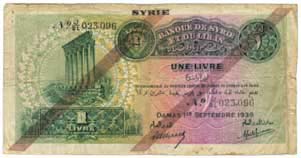

Wartime special marks were also employed by Bradbury Wilkinson & Co on Lebanese and Syrian Banknotes, printed in London. Illustrated are a £1 note with and without one of the special markings used, along with a proof of a similar marking
This idea of using the special markings on Lebanese and Syrian notes is attributed to Professor Gaston Leduc, Financial and Economic Advisor to the Free French Forces in the East between 1942 and 1945. [1. Muszynski and Klosky, as cited by Anka and Laham, 2016].
Whether or not there is a connection to the employment of special markings on Irish Legal Tender Notes and the usage of a special marking on the Lebanese and Syrian notes remains to be investigated. Both printers were located in London.
Printing of the Lebanese and Syrian notes by Bradbury Wilkinson likely predated the printing of the Irish notes. It appears to be unclear as to when the Lebanese and Syrian £1 notes with overprints started to enter circulation. Syrian overprinted £5 notes were put into circulation on 13 November, 1940; and £10 notes on 14 June, 1941 (The Official Syrian Gazette, as cited by Anka and Laham). This is long after the Currency Commission had approached Waterlow with their query regarding the Irish Legal Tender Notes special markings.
It may be that those advising the Currency Commission in early 1940 on the choice of what kind of special marking might be used had been given sight of the intended markings for the Banque de Syrie et du Liban notes, and that Drawing Specimen A might have been influenced by this.
Special markings, letters R or S in red, also appear on some Experimental US $1 Silver Certificates of Series 1935A [2. Yakes, 2018], to identify printing on Regular paper, marked R; and to test an alternative paper stock, marked S (for Special). As these notes were produced in 1944, and issued on 20 June 1944 [3], it is unlikely that the letters applied to them influenced the Currency Commission’s Specimen B drawing.
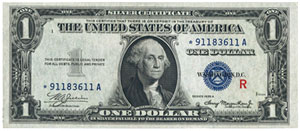

The Currency Commission decided in a meeting of 15 October 1940 to have two letters, each within a circle, instead of three, printed on each note ‘...at a point on the top left hand corner and at a point on the bottom right hand corner’, without specifying the precise locations—this was left up to Waterlow to decide.
The letter H was chosen for the 10 Shilling notes, and letter A for the £5 notes on the order. Waterlow were invited to submit sketches in the colours they considered most distinctive.
A reduction in the cost quoted for the work was sought, considering that there would now be two letters required to be added instead of the original three per note. Waterlow declined to reduce the cost, indicating that the letters would be printed in a single operation, with a negligible saving of ink by having two letters instead of three.
The fact that the pair of letters within a circle used as the special marking were printed in a single operation is illustrated by an error note, a 1943 £1 note with a double impression of the war code special marking Y, illustrated below. The degree of double impression is exactly the same in both instances of the letter, and shifted in the same direction on the note.

Detail of a war code £1 note with a double impression of the special marking Y
In some cases the contrast between the colour of the code letters and that of the other elements of the banknote’s design is insufficient to determine whether the code letter is underneath the other printing or not.
One of the clearer examples of the code letter being printed underneath the other elements of the design can be seen on £1 notes with code E. The illustration below shows a close up of a 1944 £1 note with code E, in which it can be clearly seen that the red ink of the circle is underneath the green ink of the L of ‘Legal Tender Note’.
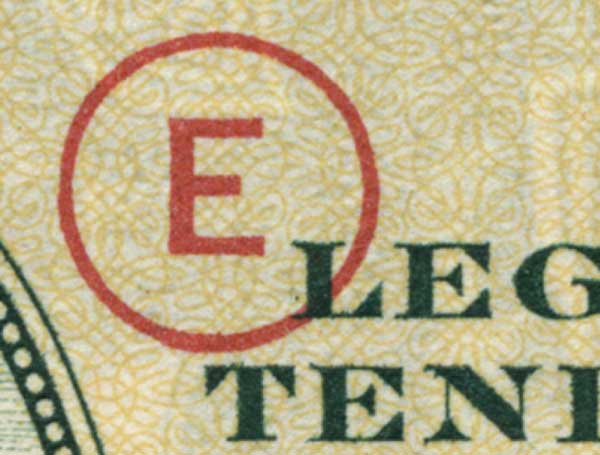
A clear example of the code letter being printed beneath the other elements of the design can be seen in this close up of a 1944 £1 note with code E
On 5 November 1940 Waterlow submitted to the Currency Commission four proofs of the 10 Shilling note, each with the H code in a different colour. This was followed on 7 November 1940 by four proofs of the £5 note with code A in different colours. Waterlow’s accompanying letters noted that the position of the special markings would vary by up to a sixteenth of an inch in location on any note. H in blue, and A in green were approved by the Currency Commission.
The entire process of the creation of the war code notes from the meeting of the Currency Commission which resulted in the sketch overlays through to the submission of the first proofs to the Currency Commission by Waterlow on 5 November 1940 took about 6 weeks.
The system was established thus, that for every print order the Currency Commission would choose the letters to be used on each denomination, Waterlow would then send proofs in several colours and the Currency Commission would choose the colour to be used.
There is no indication in the Central Bank of Ireland’s archives to suggest that the letters were not chosen at random, and no pattern to the usage of the letters has ever been discerned.
The Currency Act, 1927 [4] was required to be amended to allow for the alteration of the Legal Tender Notes. The first print order of the 10 Shilling and £5 notes were printed and delivered to the Currency Commission in Ireland before the Act was amended.
The location of the Special Marking on the notes was measured carefully by Currency Commission officials to ascertain details for inclusion in the amendment to the Currency Act. Below is illustrated the record of the details measured on £5 note number 48T 094500, and recorded for the Act.

The location of the Special Marking on each of the denominations was measured for inclusion in the amendment to the Currency Act. Illustrated is the original recording of the details measured on £5 note number 48T 094500
The positions of the code letters on each of the other denominations were also measured for legislation as they were produced, concluding with the £10 notes with code letter E being measured up on 6 June 1942. The position of the code on each denomination was slightly different.
On 15 November 1940 an amendment was made to Section 45(2) of The Currency Act, 1927 in respect of the incorporation of a special marking on the denomination of Five Pounds, by the insertion after subparagraph (a) (xiii) of paragraph (3) of a following subparagraph, (xiv). The wording to allow for the addition of the special marking letter to £5 notes was as follows, with a similar wording used for the other denominations:
(xiv) On any note bearing any date subsequent to 30th June l940 there shall appear at the top left hand side a letter of the alphabet within a circle of approximately 8 millimetres diameter the centre of which shall be approximately 54 millimetres from the left hand side of the note and approximately 27 millimetres from the top of the note. At the bottom right hand side the same letter of the alphabet shall appear within a circle of approximately 8 millimetres diameter the centre of which shall be approximately 25 millimetres from the right hand side of the note and approximately 30 millimetres from the bottom of the note. The letters of the alphabet to appear within the circles and the colours in which the letters and circles shall be printed shall be such as may be selected from time to time by the Currency Commission.
In March 1941 it was decided to use two special markings on the first batch of £1 notes bearing such marks. It appears that larger orders of millions of notes were printed in two batches and that this necessitated the usage of two code letters on such batches.
The practice was approved by the Currency Commission on 1 April 1941 once it was satisfied with Waterlow’s proposal for the manner of segregation of Legal Tender note paper bearing the two different special markings during the printing of the notes, and the Commission agreed to the printing of two Special Markings, T and B, on an order of six million £1 notes.
These two code letters were chosen and approved separately. Approval of code T was given by means of a letter dated 12 February 1941, and of code B on 22 April 1941. At the end of the print run a remainder of 50,000 blank notes which included quantities of both T and B notes was numbered with the date 3.9.41.
This resulted in the production of a very rare date, and of the first instance of a Displaced Code Variety, whereby a code letter occurs on a date out of sequence with other dates containing that same code.
Good overs was the term given to usable notes left over after the completion of a print run. These are likely a remnant of blank unnumbered notes set aside for use as replacement notes in place of errors, and any other unused stock.
The using up of good overs, sometimes with a specific unique date assigned to them has resulted in some very rare dates, and in the creation of the displaced code variety for Ten Shilling and One Pound notes. The rarest such date, 1.7.43, is the last date in the first £5 note print order of the Central Bank of Ireland printed under code N. Good overs were printed up on £5 notes from 68T 000001 onwards. This is one of the rarest of all Irish banknotes by date, with a printage of 4,000. One example of a Five Pound note dated 1.7.43 has been recorded.
The Currency Commission was very precise in the order in which good overs should be used up, specifying the serial numbers that good overs of each code should bear as well as the date under which they were to be printed.
The Commission chose the dates to appear on the notes, they were a means of keeping track of the notes. This is illustrated by the Currency Commission specifying particular dates for good overs. Sometimes good overs were printed with their own date, resulting in a rare date. Other times the good overs were printed with the last date already used in the print run. In some cases this lead to the creation of a Displaced Code Variety date, where a single date exists with either one of two code letters.
There appears to not be a pattern as to whether or not good overs were allocated their own date, or incorporated into an existing date. What appears to be clear is that the Currency Commission decided on which option to follow for each Special Marking code letter.
Interestingly, a significant number of the dates on the notes correspond to the dates of meetings of the Currency Commission Legal Tender Note Committee, suggesting that the choice of dates for the notes may not have been entirely random. Dates which fell on a Sunday were never used.
A letter to Waterlow, dated 11 February 1942 proposes 5.1.42 as a date for good overs of code C on an order of six hundred and fifty thousand £5 notes, and restricts the all the notes of the order to code C. The Currency Commission decided to not allocate two codes to £5 and £10 note orders, which were in the hundreds of thousands of notes rather than millions. The letter also allocated a date, 6.1.42, for £10 note good overs of code E.
In the case of £5 notes the date 5.1.42 was not used, presumably because there were too few notes left over to print up. A small printage of £10 notes was made dated 6.1.42, resulting in one of the rarest dates for the denomination.
The addition of the special markings was sanctioned by the Minister for Finance on 22 February 1941. It can be inferred from this that the first war code notes could not have entered circulation until sometime after this date. In fact it was more than a year later when they began to enter circulation.
An indication as to the issue rate of the Legal Tender Notes can be had from a handwritten Currency Commission document dated 5 January 1942 which proposes the estimated first issue dates of notes with Special Markings for each of the lower three denominations to be in late 1942, based on the usage of notes in stock. The estimated date of first issue of 10 Shilling notes dated 1940 was 1 August 1942.
On 19 March 1942, it was decided by the Currency Commission that £5 notes bearing Special Marking Letters could be put into circulation. This was followed on 12 May 1942 by the decision to put 10 Shilling notes bearing code H into circulation.
A hand-written note dated 9 July 1942 in the Central Bank of Ireland Archives enquires as to whether the banks should be informed in advance of the issue of notes with special markings. Apparently, they may not have been informed, as evidenced by a communication received on 7 October 1942 from a banker in Ballinacurra, Limerick, requesting clarification as to what the ‘H’ on the issue of half notes represents.
The Bank of England was informed about the special markings by a letter, dated 4 February, 1943 which starts out by acknowledging that the Bank should have been informed earlier.
It had been the practice to retain the first note of at least the lower denominations of a new type on previous occasions, as was done with the original first issue of the Legal Tender Notes in 1928, and again with the change of the Issuing Authority title from Currency Commission Irish Free State to Currency Commission Ireland on banknotes bearing dates after 1937.
In a hand-written note, dated 6 July 1942, it was proposed to retain the first 10 Shilling and £1 notes bearing the special markings ‘for the Chairman’ (Mr. Brennan).
The first £5 note to bear a code was retained, and is illustrated below. Other examples of the first code of each print run were also retained, though not of each actual code. Where a pair of codes was used in a print run it appears that just the first note of that print run was retained. Fewer of the £5 and £10 notes seem to have been retained, even though each code was a separate print order.
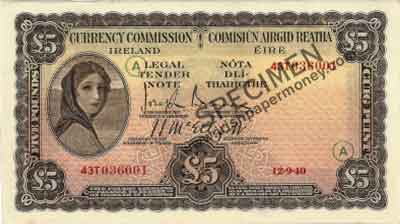
The first war code fiver. £5 notes were the first denomination to enter circulation, probably in March 1942
The first notes of each of the following codes are known to have been retained: 10 Shilling, H, L; One Pound, T, G; Five Pound, A, N; Ten Pound, S; Twenty Pound, A. This is the first SIM code note of each denomination for the two issuing authorities, with the exception of the Currency Commission £10, printed with code E.
There is no record of the first Currency Commission £10 note having been retained, and it may not have been kept.
The SIM code banknotes straddle the era when the Currency Commission Ireland was wound up and the Central Bank of Ireland established in its place in 1943. Thus, the special markings appear on notes printed under each of the Issuing Authorities.
The four lower denominations (10 Shillings through to Ten Pounds) of Currency Commission notes were printed with special marking war codes with dates in the period 1940 to 1942. The last notes before the war marks were added were £10 notes, dated 2.7.40.
After the creation of the Central Bank of Ireland in 1943 production of notes continued with the special marking in place. The five lower denominations of Central Bank of Ireland notes were printed with SIM codes in the period 1943 to 1944.
Preparation of the £20 note was underway in late December 1943, after its initial order on 19 November 1943. On 21 December 1943 the Legal Tender Note Committee selected the letter A within a circle in black, to appear on the £20 note, in an order of 30,000 notes plus good overs.
On 29 February 1944 the committee decided to substitute dark blue as the selected colour in place of black for the £20 special marking. This is the only record that has come to light of a colour being changed on a code letter after its selection being confirmed to the printers.
Special markings were not employed for a printage of 9,300 £50 notes, ordered in March 1943; and 5,000 £100 notes, ordered in June 1943, all of which bore dates in 1943.
The omission of a Special marking on either of these two orders may have been due to the small number of notes involved. Also, as these notes were the first of the new design type, with issuing authority changed to ‘The Central Bank of Ireland’ and would likely all have been in a single shipment it would have been very straightforward to cancel them in the event of their being scattered or destroyed.
The Central Bank of Ireland Statement of Accounts for the year ended March 31, 1945 shows that 1943-dated £50 notes were in circulation by then, which is long in advance of the discontinuation of the usage of special markings.
The special marking letter code was discontinued on banknotes dated from January 1945 onwards. The last selection of special marking letters was made by Central Bank officials on 6 March 1945 for an order, placed on 11 January 1945, of £1 notes bearing codes E and F, and for £10 notes bearing code G. This was confirmed by Waterlow in a letter dated 13 March 1945.
The first post-SIM war code note was a £5, dated 17.1.45, part of a print order made on 4 May 1945, which was shortly after the death of Hitler had been announced and a few days before VE Day on 8 May 1945. Special markings were immediately discontinued after Allied victory in Europe.
In all, twenty eight different SIM codes were used as special markings, employing twenty different letters and many colour variations. Illustrated below are the letters employed as a special marking for each denomination in the order in which the letters were approved by the Issuing Authority, as distinct from the order in which the code letters were printed. The letters are illustrated in the colour used for each printing.
The letters I, O, Q, U, X, and Z were not used. The first four of these are the letters which were always avoided in serial prefixes on the Series A notes. Perhaps this precluded their use as SIM codes also. There is no mention of the letter X or Z in relation to the special markings in the Central Bank archives.

Special Identification Markings used as War Codes on Irish World War 2 banknotes 1940-1944
The twenty different letters of the alphabet which were employed as special markings are illustrated above in the colours used for each marking, in the order in which the letters were approved by the Issuing Authority. Some letters were used more than once, creating 26 distinct special markings which were used as war codes
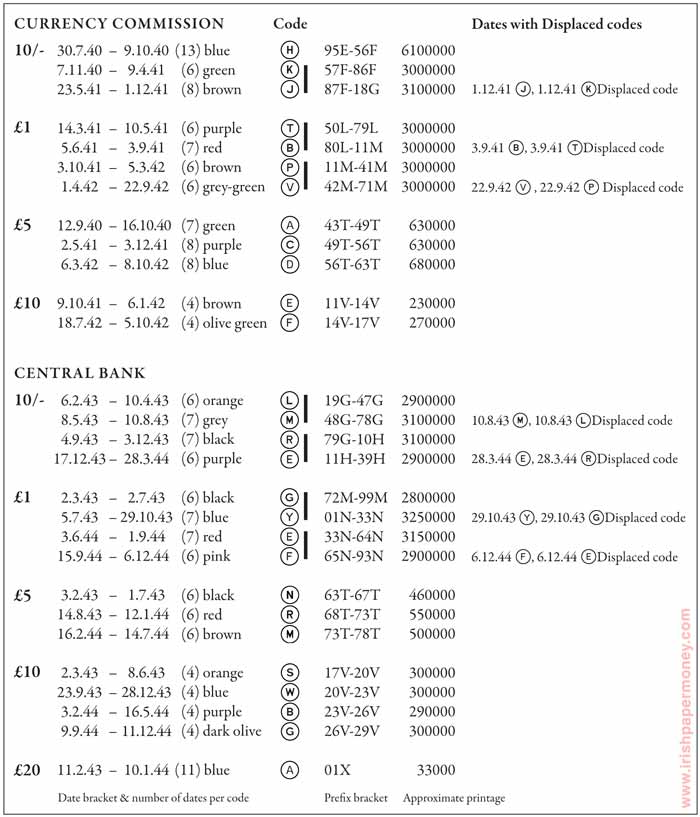
Table 1. Twenty eight different SIM war codes were used as special markings, employing twenty different letters and many colour variations. Instances where two codes were printed together are marked with a heavy line, and Displaced codes are indicated where they occur
It is to be hoped that examples have survived of proofs and artwork generated during the development and production of the war era banknotes with special markings on them, and that in time they will become available to researchers.
The initial partial proof produced of a £5 note with three code letters on it would be an item of particular interest, as would proofs of letters in colours which were not selected for use as special markings on the war code notes.
Linked Picture Pages of War Code Notes
Currency Commission Ireland Type 4 1940-42
Central Bank of Ireland 1943 War Code Specimen Images
Central Bank of Ireland War Code Notes Type 5 1943-44
Revised Version (2023)
Original [print] version (2020), published in Coin News in two parts as 'Scatter Risk and Special Markings', September 2020, p76; October 2020, p79.
Revised [electronic] version (2023) www.irishpapermoney.com/forum/viewtopic.php?f=22&t=353 Numismatic Articles and Papers / Occasional Papers on Irish Paper Money.
References
The core content of this page is based closely on a Coin News article (2020), cited above, which is the publication of research carried out at the Central Bank of Ireland Archives, Dublin on 15 December 2017.
B. Central Bank of Ireland Archives, Dublin. Referred to as CBIAR in the text. [Accessed 15 December 2017].
All images reproduced by curtsey of the Central Bank of Ireland Archives.
1. Anka, T, and Laham, W. (2016), 'L’Histoire du Papiere-Monnaie Libanais', Dergham, Beyrouth, Liban.
2. Yakes, J. (2018). 'R & S Experimental 1935A Silver Certificates', Educational Seminar, International Paper Money Show 2018, Kansas Mi, June 7-10. <https://www.youtube.com/watch?v=R_c2bW6oFnc> [Last retrieved 29.10.23].
3. R & S Experimental 1935A Silver Certificate delivery date: <http://www.uspapermoney.info/general/deliv_s.html> [Last retrieved 29.10.23].
Referenced Acts of Parliament
4. Currency Act (1927). <https://www.irishstatutebook.ie/eli/1927/act/32/enacted/en/html?q=currency+act&years=1927> [Last retrieved 29.10.23]
5. Emergency Powers Act, 1939. <https://www.irishstatutebook.ie/eli/1939/act/28/enacted/en/print> [Last retrieved 29.10.23].
General References
6. Mac Devitt, M. (1999). 'Irish Banknotes. Irish Government Paper Money From 1928'. Seachran & Whytes.
7. Mac Devitt, M. (2019). 'Irish Banknotes. Irish Paper Money From 1928—2001'. 4th ed, Seachran.
8. Mac Devitt, M. (2021). 'Scatter Risk and Special Markings, The Irish World War II ‘War Code’ Banknote Issues', 1940-1944. 1st ed, Seachran.
9. Young, D. (1972). Guide to the Currency of Ireland, Legal Tender Notes, 1928-1972.
10. The Banknote Yearbook, 9th Ed., (2015). Token Publishing Ltd.
Special Sections and Articles
The Transition of Irish Currency, Irish banknotes 1918–1928
The Partition of Irish Currency, Irish banknotes 1928–1930
Banknote Design Evolution 1824 to 1916
Irish Three Pound Notes
Contemporary Forgeries of Early Irish Banknotes, ca1800-1930
Limerick Soviet Notes
Irish World War 2 Banknote Issues
Low Number Irish Banknotes
Irish Joint Stock Banks of Note Issue from 1783
Irish Legal Tender Note Specimens
Ploughman Scan Survey (PSS)
1 Pound Ploughman
5 Pounds Ploughman
10 Pounds Ploughman
20 Pounds Ploughman
50 Pounds Ploughman
100 Pounds Ploughman
Irish Ten Shilling Notes
1 Pound Note Lady Lavery
5 Pounds Lady Lavery
10 Pounds Lady Lavery
20 Pounds Lady Lavery
50 Pounds Lady Lavery
100 Pounds Lady Lavery
1 Pound Note, Queen Medb
5 Pound Note, John Scotus Eriugena
10 Pound Note, Jonathan Swift
20 Pound Note, W. B. Yeats
50 Pound Note, Turlough O'Carolan
100 Pound Note, Grace O'Malley
5 Pound Note, Sister Catherine McAuley
10 Pound Note, James Joyce
20 Pound Note, Daniel O'Connell
50 Pound Note, Douglas Hyde
100 Pound Note, Charles Stewart Parnell
![]() Stable version. Last update 29.10.23
Stable version. Last update 29.10.23